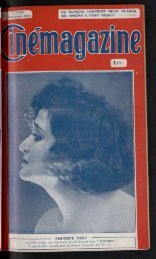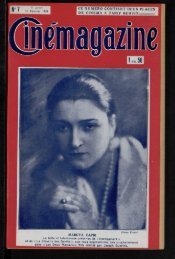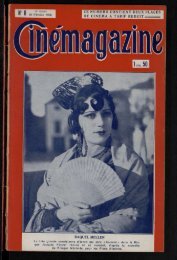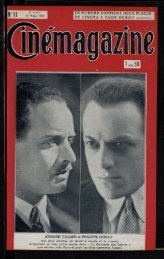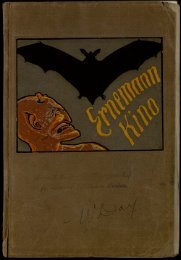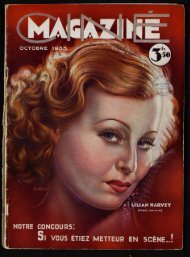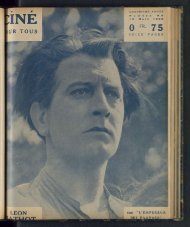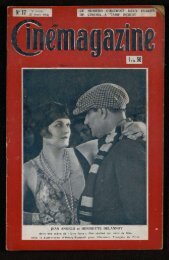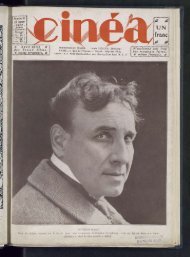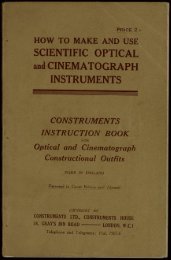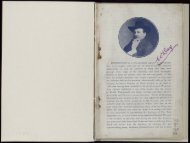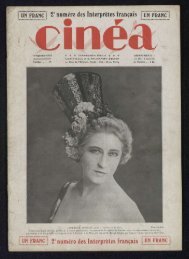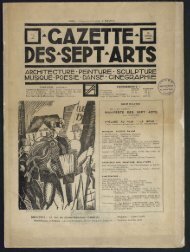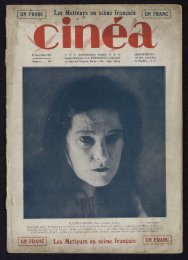Untitled
Untitled
Untitled
Create successful ePaper yourself
Turn your PDF publications into a flip-book with our unique Google optimized e-Paper software.
80 MODERN MAGIC LANTERNS.<br />
difficult to realise what the combined result of any two<br />
geometrical designs so revolving will be. Very fine patterns<br />
resembling " watered " silk can be got by mounting fabrics<br />
such as netting, muslin, etc., with a clear and well-defined<br />
thread, in such a revolving arrangement, taking care, to<br />
secure the best result, that the two fabrics shown together<br />
are similar.<br />
Revolving slides, on the principle of the chromatrope, are<br />
made having such things as windmills with revolving sails,<br />
acrobats spinning round on a trapeze, fish swimming in a<br />
globe, bees round a hive, etc., for their subjects ; and can be<br />
obtained from most dealers.<br />
The various slides alluded to above can all be shown by<br />
means of a single lantern, but those now to be mentioned<br />
require at least a biunial for their exhibition. With such<br />
an instrument the number of combinations, effects, etc., that<br />
can be obtained is almost unlimited. The simplest of these<br />
is the curtain slide, in which the picture on the screen is<br />
shown with a curtain round it, as if it were on the stage of<br />
a theatre. A balcony or verandah slide is sometimes used<br />
in place of the curtain ; the scene then appears to be viewed<br />
from the interior of a room, looking out over the balcony.<br />
In these and similar effects, the curtain or balcony, as the<br />
case may be, is projected by means of one of the lanterns,<br />
the cther being used to throw the usual slides in the blank<br />
space left for that purpcse in the " curtain " slide. It<br />
should be borne in mind that this entails the use of a great<br />
deal of gas, as both lanterns have to be kept going all the<br />
time.<br />
A carrier has just been introduced by Mr. G. Davenport<br />
in which the screen is darkened during the change of slide<br />
by art opaque curtain, which appears to come down and<br />
mask one picture, rising afterwards and revealing the fresh<br />
slide. Such a carrier, with a curtain or border slide of any<br />
kind in the other lantern, would no doubt give a pleasing<br />
effect.<br />
Akin to these are snow and rain effects. These are<br />
obtained by means of a slide in which a roll of opaque<br />
material is gradually unwound through the lantern. For<br />
snow, the fabric is pierced with little holes, for rain it is<br />
MOVING SLIDES AND EFFECTS.<br />
mr,rked with fine lines. In both these cases the effect is<br />
improved if the slide is not inserted in the lantern in a<br />
perfectly horizontal manner, but is slightly inclined, so as to<br />
give the idea of a little wind. It is important, moreover, if<br />
the illusion is to be of the best, that the light in the lantern<br />
showing the rain or snow slide shall not be too powerful ;<br />
especially is this the case with the rain. The writer<br />
remembers seeing a lantern display in which a poor waif,<br />
seated on a doorstep, was exposed to what was intended to<br />
be a shower of rain. Owing to the operator having, if anything,<br />
a brighter light in the "rain "lantern than the other,<br />
the shower suggested nothing so much as one of white hot<br />
knitting-needles, and the effect on the audience was anything<br />
but what was intended.<br />
Moonlight effects are obtained by means of a biunial<br />
lantern and two slides, the subjects upon each being<br />
absolutely identical as regards outline, but one can be very<br />
much more vigorous than the other. With photographic<br />
slides, which are much the best for the purpose, this<br />
difference can easily be obtained. The first slide, intended<br />
to depict the daylight view, can be made in the usual way,<br />
with the usual amount of density and contrast. The second<br />
slide, however, should be exposed for a little under the<br />
suitable time, and should be developed with a view to<br />
getting plenty of contrast, rather than what a photographer<br />
would describe as a soft result. This second slide must<br />
then be treated with a bath of a deep blue aniline dye, so<br />
as to give it that blue tint usually associated with moonlight<br />
views. Any lights which it is intended shall appear in it,<br />
such as gas-lamps, illumined windows, stars, the moon<br />
itself or its reflection on the water, must then be carefully<br />
picked out so as to leave the slide bare where it is intended<br />
these shall be. The two slides being then most carefully<br />
registered, the daylight picture is first shown, and gradually<br />
dissolved into the moonlight one.<br />
Such effects can be multiplied almost without limit, by<br />
having accurately registered slides and plenty of assistance.<br />
The number of lanterns required rarely exceeds three in the<br />
most elaborate displays, since in nearly every case the effect<br />
at any one time is obtained by the two lanterns, leaving the<br />
81



